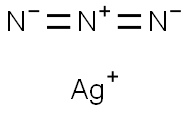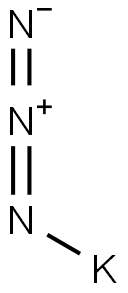Lithium azide
Synonym(s):Lthium triazide
- CAS NO.:19597-69-4
- Empirical Formula: LiN3
- Molecular Weight: 48.96
- MDL number: MFCD00041956
- EINECS: 243-177-1
- SAFETY DATA SHEET (SDS)
- Update Date: 2024-12-18 14:07:02

What is Lithium azide?
Chemical properties
clear colorless solution
The Uses of Lithium azide
Lithium azide is the lithium salt of Hydrazoic acid and is used to carry out azidolysis reactions (in Acetonitrile), as well as ring opening reactions of aromatics such as Styrene oxide (S687795).
Purification Methods
Digest ~1g with 15mL of 96% EtOH at 35o, filter and dry it in air at temperatures below 80o. Store it in a cool place and treat it as potentially explosive. Its solubility in H2O is 66.4% at16o, and 20.26% at16o in EtOH. [Hofmann-Bang Acta Chem Scand 11 581 1957, Schenk in Handbook of Preparative Inorganic Chemistry (Ed. Brauer) Academic Press Vol I p 581 1963.]
Properties of Lithium azide
| Melting point: | decomposes at 115–298℃ [CRC10] |
| Boiling point: | 103 °C |
| Density | 1.088 g/mL at 25 °C |
| solubility | soluble in Water |
| form | Liquid |
| color | Clear colorless |
| Water Solubility | g/100g H2O: 61.3 (0°C), 67.2 (20°C), 86.6 (60°C) [LAN05] |
| EPA Substance Registry System | Lithium azide (Li(N3)) (19597-69-4) |
Safety information for Lithium azide
| Signal word | Danger |
| Pictogram(s) |
 Skull and Crossbones Acute Toxicity GHS06 |
| GHS Hazard Statements |
H311:Acute toxicity,dermal |
| Precautionary Statement Codes |
P280:Wear protective gloves/protective clothing/eye protection/face protection. |
Computed Descriptors for Lithium azide
Lithium azide manufacturer
Innovative Labs
1Y
Phone:+91-9885794886
Whatsapp: +91-9885794886
product: 19597-69-4 Lithium azide 98%
New Products
Tert-butyl bis(2-chloroethyl)carbamate (S)-3-Aminobutanenitrile hydrochloride N-Boc-D-alaninol N-BOC-D/L-ALANINOL 3-(2,4-Dimethoxybenzyl)dihydropyrimidine-2,4(1H,3H)-dione 7-Bromo-1H-indazole N-octanoyl benzotriazole 3,4-Dibenzyloxybenzaldehyde 4-Hydrazinobenzoic acid Electrolytic Iron Powder Fmoc-Val-Cit-PAB 1,1’-CARBONYLDIIMIDAZOLE R-2-BENZYLOXY PROPIONIC ACID 4-HYDROXY BENZYL ALCOHOL 1,1’-CARBONYLDI (1,2-4 TRIAZOLE) S-2-CHLORO PROPIONIC ACID (2-Hydroxyphenyl)acetonitrile 4-Bromopyrazole 5-BROMO-2CYANO PYRIDINE 5,6-Dimethoxyindanone 5-broMo-2-chloro-N-cyclopentylpyriMidin-4-aMine 1-(4-Methylphenylsulfonyl)-1H-1,2,3-benzotriazole 1-(2-Chlorobenzyl)-4-nitro-1H-pyrazole 1-(2-Nitrophenyl)-4-phenylpiperazineRelated products of tetrahydrofuran








You may like
-
 19597-69-4 Lithium azide 98%View Details
19597-69-4 Lithium azide 98%View Details
19597-69-4 -
 Lithium azide, 20% w/w, solution in water CAS 19597-69-4View Details
Lithium azide, 20% w/w, solution in water CAS 19597-69-4View Details
19597-69-4 -
 Lithium azide solution CAS 19597-69-4View Details
Lithium azide solution CAS 19597-69-4View Details
19597-69-4 -
 Ste-Glu-AEEA-AEEA-OSUView Details
Ste-Glu-AEEA-AEEA-OSUView Details
1169630-40-3 -
 1446013-08-6 Fmoc-His-Aib-OH TFA 98%View Details
1446013-08-6 Fmoc-His-Aib-OH TFA 98%View Details
1446013-08-6 -
 127464-43-1 99%View Details
127464-43-1 99%View Details
127464-43-1 -
 2-ETHYLPYRIDINE 100-71-0 99%View Details
2-ETHYLPYRIDINE 100-71-0 99%View Details
100-71-0 -
 13162-05-5 99%View Details
13162-05-5 99%View Details
13162-05-5
Statement: All products displayed on this website are only used for non medical purposes such as industrial applications or scientific research, and cannot be used for clinical diagnosis or treatment of humans or animals. They are not medicinal or edible.